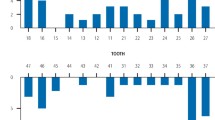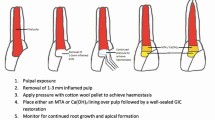Key Points
-
Describes the different indications for performing a root canal treatment.
-
Discusses the different technicalities of a root canal treatment in different clinical situations.
-
Discusses the influence of the pre-operative pulpal and peri-radicular status on the treatment outcome.
Abstract
Root canal treatment is a frequently performed procedure aimed to address pulpal and peri-radicular disease. It comprises a number of clinical steps regardless of the initial diagnosis. The emphasis of each step varies according to whether there is a vital pulp (non-infected) or if the pulp system contains necrotic, infected tissue and there is peri-apical pathology. This article aims to discuss the differences in performing root canal treatments on teeth with vital and non-vital pulps. The reader should understand the differences between performing a root canal treatment in teeth with vital pulps and those with infected root canal spaces and peri-radicular pathology.
Similar content being viewed by others
Log in or create a free account to read this content
Gain free access to this article, as well as selected content from this journal and more on nature.com
or
References
Langeland K . Tissue response to dental caries. Endodon Dent Traumatol 1987; 3: 149–171.
Nair P N R . Pathobiology of primary apical periodontitis. In Cohen S, Hargreaves KM Pathways of the pulp. 9th ed. pp 541–579. Missouri: Mosby, 2006.
Fowler S, Reader A . Is a volume of 3.6 mL better than 1.8 mL for inferior alveolar nerve blocks in patients with symptomatic irreversible pulpitis? J Endod 2013; 39: 970–972.
Hargreaves K M, Keiser K . Local anesthetic failure in endodontics: mechanisms and management. Endod Topics 2002; 1: 26–39.
Jungermann G B, Burns K, Nandakumar R, Tolba M, Venezia R A, Fouad A F . Antibiotic resistance in primary and persistent endodontic infections. J Endod 2011; 37: 1337–1344.
Abbott P V, Hume W R, Pearman J W . Antibiotics and endodontics. Aust Dent J 1990; 35: 50–60.
Weine F S, Kelly R F, Lio P J . The effect of preparation procedures on original canal shape and on apical foramen shape. J Endod 1975; 1: 255–262.
Shovelton D S . The presence and distribution of microorganisms within non-vital teeth. Br Dent J 1964; 117: 101–107.
Baugh D, Wallace J . The role of apical instrumentation in root canal treatment: a review of the literature. J Endod 2005; 31: 333–340.
Ram Z . Effectiveness of root canal irrigation. Oral Surg Oral Med Oral Pathol 1977; 44: 306–312.
Ricucci D, Langelaand K . Apical limit of root canal instrumentation and obturation II. A histological study. Int Endodon J 1998; 31: 394–409.
Wu M K, Wesselink P R, Walton R E . Apical terminus location of root canal treatment procedures. Oral Surg Oral Med Oral Pathol Oral Radiol Endod 2000; 89: 99–103.
Zehnder M . Root canal irrigants. J Endod 2006; 32: 389–398.
Jungbluth H, Peters C, Peters O, Sener B, Zehnder M . Physicochemical and pulp tissue dissolution properties of some household bleach brands compared with a dental sodium hypochlorite solution. J Endod 2012; 38: 372–375.
Mancini M, Cerroni L, Iorio L, Armellin E, Conte G, Cianconi L . Smear layer removal and canal cleanliness using different irrigation systems (endoactivator, endovac, and passive ultrasonic irrigation): field emission scanning electron microscopic evaluation in an in vitro study. J Endod 2003; 39: 1456–1460.
Stojicic S, Zivkovic S, Qian W, Zhang H, Haapasalo M . Tissue dissolution by sodium hypochlorite: effect of concentration, temperature, agitation, and surfactant. J Endod 2010; 36: 1558–1562.
Sirtes G, Waltimo T, Schaetzle M, Zehnder M . The effects of temperature on sodium hypochlorite short-term stability, pulp dissolution capacity, and antimicrobial efficacy. J Endod 2005; 31: 669–671.
Zou L, Shen Y, Li W, Haapasalo M . Penetration of sodium hypochlorite into dentin. J Endod 2010; 36: 793–796.
Siqueira Jr J F . Microbial causes of endodontic flare-ups. Int Endod J 2003; 36: 453–463.
Zehnder M, Paque F . Disinfection of the root canal system during root canal re-treatment. Endod Topics 2011; 19: 58–73.
Fuss Z, Lustig J, Tamse A . Prevalence of vertical root fractures in extracted endodontically treated teeth. Int Endodon J 1999; 32: 283–286.
European Society of Endodontology. Quality guidelines for endodontic treatment: consensus report of the European Society of Endodontology. Int Endod J 2006; 39: 921–930.
Sjögren U, Hägglund B, Sundqvist G, Wing K . Factors affecting the long-term results of endodontic treatment. J Endod 1990; 16: 498–504.
Ng Y L, Mann V, Gulabivala K . A prospective study of the factors affecting outcomes of nonsurgical root canal treatment: part 1: periapical health. Int Endod J 2011; 44: 583–609.
Author information
Authors and Affiliations
Corresponding author
Additional information
Refereed Paper
Rights and permissions
About this article
Cite this article
El-Ma'aita, A., Qualtrough, A., Darcey, J. et al. Rethinking root canal treatment: understanding the difference between preventing and treating endodontic infection. Br Dent J 219, 13–16 (2015). https://doi.org/10.1038/sj.bdj.2015.527
Accepted:
Published:
Issue date:
DOI: https://doi.org/10.1038/sj.bdj.2015.527



